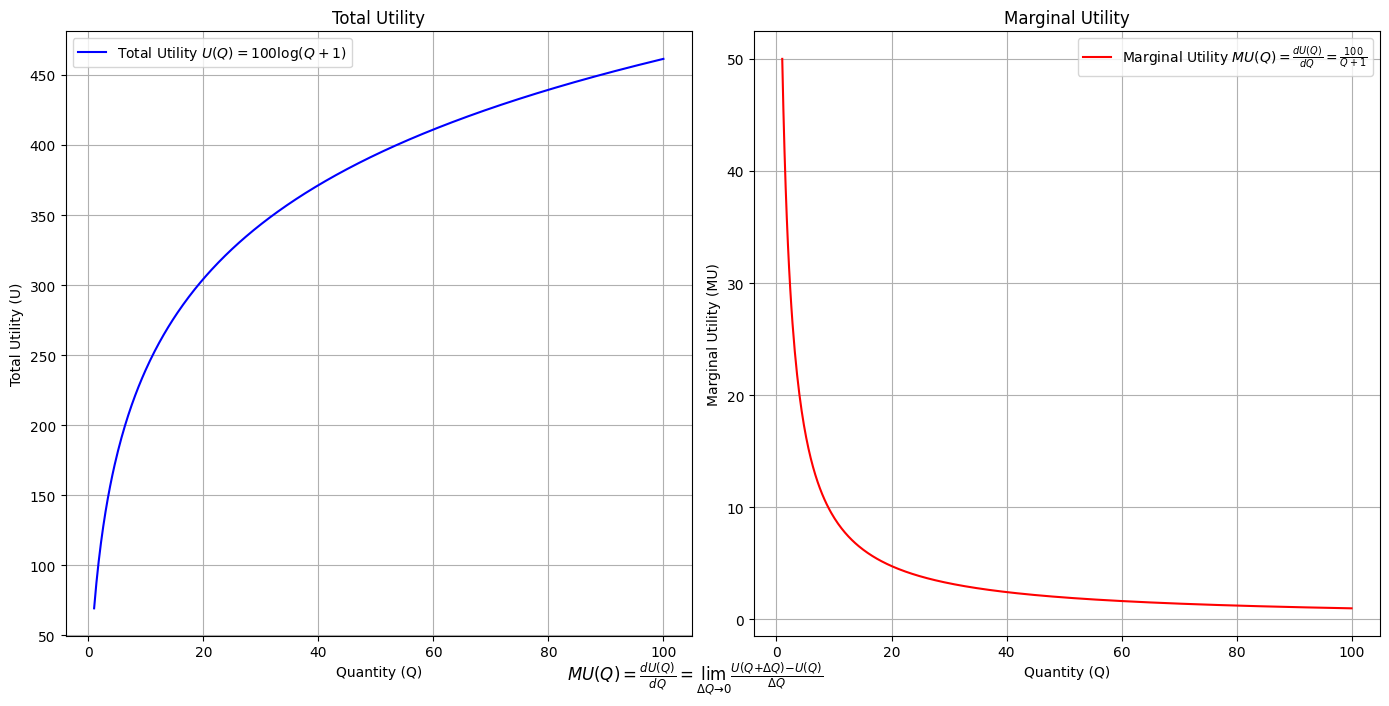Padre#
What you owe your children:
A succinct worldview
Be that person who can say “my cup runneth over”
If someone needs to be rescued, you’ve the resources no matter the person-place-time
Such a hero
encodeseverything “strong”
Food & shelter
Love
1. f(t) \ 2. S(t) -> 4. y:h'(f)=0;t(X'X).X'Y -> 5. b(c) -> 6. SV' / 3. h(t)
\(\mu\), Chaos#
Text: distribution of social income
Cumulation of wealth
Time in life when most is made
\(\sigma\), Order#
Context: homogeneity vs. stronger influences of migration
\(\%\), Accuracy#
Pretext: vector of coefficients that determine subgroup identity
Individualized profile
Show code cell source
import numpy as np
import matplotlib.pyplot as plt
# Define the total utility function U(Q)
def total_utility(Q):
return 100 * np.log(Q + 1) # Logarithmic utility function for illustration
# Define the marginal utility function MU(Q)
def marginal_utility(Q):
return 100 / (Q + 1) # Derivative of the total utility function
# Generate data
Q = np.linspace(1, 100, 500) # Quantity range from 1 to 100
U = total_utility(Q)
MU = marginal_utility(Q)
# Plotting
plt.figure(figsize=(14, 7))
# Plot Total Utility
plt.subplot(1, 2, 1)
plt.plot(Q, U, label=r'Total Utility $U(Q) = 100 \log(Q + 1)$', color='blue')
plt.title('Total Utility')
plt.xlabel('Quantity (Q)')
plt.ylabel('Total Utility (U)')
plt.legend()
plt.grid(True)
# Plot Marginal Utility
plt.subplot(1, 2, 2)
plt.plot(Q, MU, label=r'Marginal Utility $MU(Q) = \frac{dU(Q)}{dQ} = \frac{100}{Q + 1}$', color='red')
plt.title('Marginal Utility')
plt.xlabel('Quantity (Q)')
plt.ylabel('Marginal Utility (MU)')
plt.legend()
plt.grid(True)
# Adding some calculus notation and Greek symbols
plt.figtext(0.5, 0.02, r"$MU(Q) = \frac{dU(Q)}{dQ} = \lim_{\Delta Q \to 0} \frac{U(Q + \Delta Q) - U(Q)}{\Delta Q}$", ha="center", fontsize=12)
plt.tight_layout()
plt.show()


Distribution of biological traits vs. family wealth. Capitalism is associated with the Weibull distribution. Communism claims to offer a uniform distribution.#
This framework captures concepts like archetype, viriletype, stereotype, and mytype
Base-case (from largest subgroup)
\(f(t)\)
\(S(t)\)
\(h(t)\)
Group \((X'X)^T \cdot X'Y\)
Individual
Subgroup \(\beta\)
Personalized \(SV'\)
Essays#
Anthony Bourdain’s distinction lies in interchange of modes, qualities, and relatives. In Tuscany we are fussing about Dante Allegheri’s allegory (No boundaries) and in Tokyo we are analyzing the value of Judo to a sushi chef (Parts Unknown). Other food channels talk only about food
I Chopin#
ii: Inherited Fetters (+ Self-Imposed) 1, 2, 3#
Summary: ii. departure - V7. struggle - i. return. This is drawn from the interchange of modes, qualities, and relatives in the context of Aeolian i/III that is always in the 1st inversion. Chopin inherited this from the 2nd, 3rd, and 4th opening bars of “Lacrimosa” (Aeolian with a Phrygian element much later).
A bii chord from the Phrygian mode may be inserted. Its qualities may then be varied: bII7 - bII6 - biiø7 - biidim7. This chord non-progression might come after the Aeolian iim7b5 in a return to home. A return to a false i via an Ionian I7 lends seamless voice leading from bii7-bii°7-biiø7-I7. And then we return to the Aeolian root as follows: I7 - idim7 - im7. So thats a quick dash across three modes!
My inheritance here from Chopin, my ancestor, is one of “chains”: how daintily he dances in the chains at bii. He again does so later at V7b9 (tonic E minor) - V7 - vm7 - vdim7 (relative G Major), and finally in a very deceptive cadence on the home melody (E) at Vb9 - Vb97 - V7sus - V7sus13 - V7susb13 - Vb97/Vb7. Such chord non-progression is akin to a dam holding back a river from its destiny at the estuary. Once the sluice gates open, my banks will overflow. Mozart gave to Chopin, Chopin gave to me, and thus it is my duty to perform acts of charity for the next generation.
V7: Dancing in Chains 4#
Inherited “chains” become an arena for demonstrating resilience and creativity, much like complex chord progressions that defy straightforward resolution. If I’m to play the hero in my lifetime, it is because others have placed hope in me, given that “my cup runneth over.” They are right because to them it seems that I effortlessly dance in these inherited and self-imposed fetters and obstacle courses during my odyssey.
i: Born to Etiquette 5, 6#
Our premise in discussing these matters is that a mere ii-V7-i progression without the transformations (insertions and deletions) would be a bland moral tale of faith.
The aesthetic accomplishment is in overcoming a seemingly endless and randomly generated number of barriers, and worthy adversaries, with grace and poise. This is much more compelling than the contrived, tidy ii-V7-i. With so many transformations, the overarching ii-V7-i can’t even be perceived and so it never seems contrived.
2 Manga#
Inherited Fetters#
Japanese culture places a significant emphasis on tradition , which often manifests in the storytelling of Seinen manga. Protagonists have implied real-world “public” pressures that individuals overcome with “private” pleasure.
Dancing in Chains#
One of the aspects of Seinen manga is its exploration of S&M themes, where characters experience pleasure and pain through the lens of bondage and dominance. This can be seen in works like “Nana to Kaoru,” where the protagonists explore their sexual fantasies and fetishes within the bounds of consensual relationships. The chains here are both literal and metaphorical.
Born to Etiquette#
A unique aspect of Japanese media is the legal restriction on depicting human genitalia, which has led to creative circumventions in manga and anime. This legal fetter has given rise to inventive storytelling techniques and visual metaphors, such as the use of aliens or tentacles. These elements allow creators to explore adult themes and sexual content while adhering to legal boundaries. By adopting otherworldly or fantastical modes, they can push the boundaries of expression and explore taboo subjects. This creative freedom within legal limits is exemplified in works like “Shokugeki no Soma,” where food and sensuality are intertwined in a way that titillates without explicit depiction.

